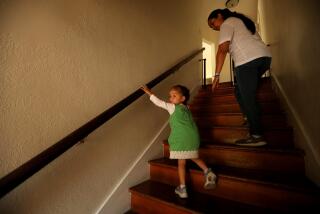Home Prices Seen Bar to Young Buyers
- Share via
WASHINGTON — Most well-housed Americans are delighted with their own dwellings, but a majority (57%) believes that there is not enough housing in their areas for lower-middle class families. The surveyed group favors rehabilitation of existing dwellings and new construction--or a combination thereof--to help less adequately housed fellow citizens.
A 1986 Gallup poll, commissioned by the Urban Land Institute, found that 70% of the general adult population owns houses, and that 85% of “opinion leaders” (elected and appointed officials and professional people, writers and ULI members) live in their own homes.
Despite general satisfaction with their homes, which they expect to be habitable 50 years from now, both groups took the view that housing is more expensive than other essential goods. The general public blamed government, contractors, lenders and real estate interests for the high costs of housing, whereas the opinion leaders cited the supply-demand economy and related economic factors.
“The high cost of entry-level housing for young, first-time buyers really concerns me, and it should be a priority item for our nation,” Washington realtor Charles Purcell said. He added that the present generation of working couples and singles in the 24-to 35-year-age group would be having a much harder time buying a first dwelling if parents and relatives were not often supplying gifts and interest-free loans.
Builder Robert Libson, who concentrated on low entry-level housing until this year, said he switched to larger, higher-priced homes for move-up buyers mainly because that market is more active. “Rising costs forced up the prices of my smaller town houses and single-family dwellings, and the market potential declined,” Libson said.
Builder-developer Angelo Puglisi suggested that municipalities could foster more lower-priced housing for young first-time buyers by zoning land for semi-detached and town houses on relatively small lots.
“Land costs are prohibitive today and developers have to pass that cost along to buyers,” Puglisi said. “Yet, every city and town has some lesser-priced raw land that could be converted into attractive small subdivisions by builders with imagination and determination to aid young buyers.”
But there’s also some concern, as shown by the Gallup telephone poll for ULI, about housing for the nation’s growing elderly population. Almost 90% of all persons surveyed said there should be more emphasis on allowing older persons to stay in their own homes by providing outside services.
The same large percentage of the public also supported development of more retirement communities with nursing facilities. When polled, older persons (65 and up) agreed with those views.
One result of the nationwide poll was that about 65% of the general public felt that more retirement communities should permit children of older persons to be in residence and that more separate apartments should be provided for retirees in family homes. However, a lesser percentage (57%) of polled older persons supported those options.
On other topics the poll for ULI found that:
-- Most people (81%) would not want to move into the downtown areas of their nearest cities.
-- Traffic and parking are major problems in downtowns but only 56% favor suburban shopping malls over central city retail stores.
-- Most of those surveyed like their neighborhood density of population and blamed local residents for any neighborhood deterioration. Few expect their communities to decline. Southerners are much more inclined to believe that their communities will improve than are Easterners, Midwesterners and Westerners.
-- Overall, developers have a favorable image for their interest in aesthetic values. However, 74% of those responding contend those same developers are not paying enough attention to the environmental aspects of their projects.
The Urban Land Institute, which includes many of the nation’s leading developers, builders and architects among its members, is marking its 50th anniversary this year.
More to Read
Sign up for Essential California
The most important California stories and recommendations in your inbox every morning.
You may occasionally receive promotional content from the Los Angeles Times.






